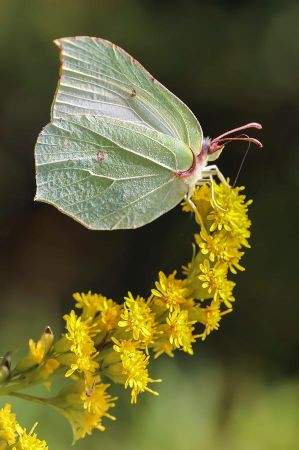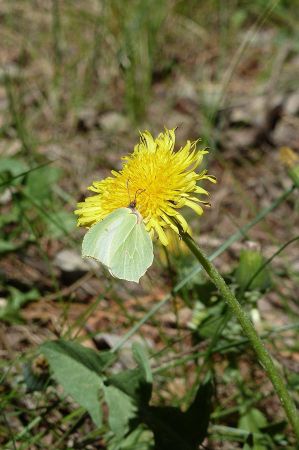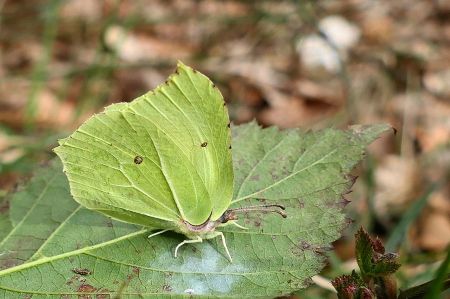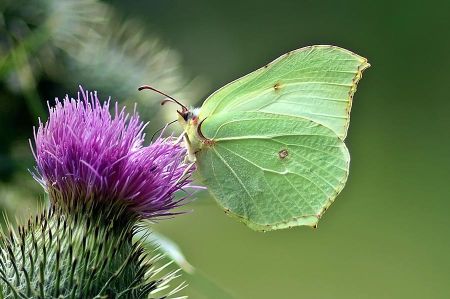Brimstone butterflies usher in spring
- Written by Portal Editor
When the days get warmer and the sun shines, the first butterfly of the year appears: the bright yellow brimstone butterfly (Genopteryx rhamnis) can be seen in parks and gardens with its typical flight - sometimes it rises up, then it drops down.
“Only the males have the strong yellow spring colour,” says Alice Kracht, insect expert at the German Wildlife Foundation, “female butterflies have a greenish-white wing cover.” The wings of both sexes are reminiscent of tree leaves with their clearly prominent veins. Both males and females have an orange spot in the middle of the wing.
First butterfly of the year flies again
 The fact that brimstone butterflies are the first butterflies to leave their winter hiding places in March is because they spend the cold months in a state of torpor as adult butterflies - and not as eggs, caterpillars or pupa.
The fact that brimstone butterflies are the first butterflies to leave their winter hiding places in March is because they spend the cold months in a state of torpor as adult butterflies - and not as eggs, caterpillars or pupa.
If the temperatures climb to around 14 degrees, they are immediately fully capable of flying. After winter they need food to recharge their batteries.
And the mating season is approaching: “The females ready to mate are pursued by the males in wild flight. During courtship, they often climb high into the treetops,” says Kracht, describing the spectacular flight manoeuvres of the delicate animals.
Early bloomers such as daphne, willow and larkspur provide food with their sweet nectar. In summer, when the new generation of butterflies have hatched, purple loosestrife and cabbage thistle are nutritious sources of nectar.
 The green, porcelain-like shiny caterpillars of the brimstone butterfly, on the other hand, only feed on buckthorn and buckthorn species. “Incidentally, this is the hallmark of many butterfly species: their caterpillars are specialized on very specific food plants,” says Kracht.
The green, porcelain-like shiny caterpillars of the brimstone butterfly, on the other hand, only feed on buckthorn and buckthorn species. “Incidentally, this is the hallmark of many butterfly species: their caterpillars are specialized on very specific food plants,” says Kracht.
Incidentally, brimstone butterflies are not only the first, but also the last butterflies that we can observe in nature: with a lifespan of ten months, they are the oldest of all butterflies.
From September onwards they look for overwintering places in tree crevices, on the underside of a blackberry leaf or in an ivy hedge until they delight us again with their splendour of colour next spring.
How are butterflies doing in Germany?
 According to Germany's Red List Centre, 49 percent of butterfly species in Germany are considered "rare" to "extinct or lost." 47 percent are classified in the “moderately common” to “very common” categories. The brimstone butterfly is still in the “endangered” category on the Red List of butterflies. Other butterflies have a harder time than him: wet meadows, poor and dry grasslands, structured bushes and forest edges, the habitats of many specialized butterflies, are becoming increasingly rare. The German Wildlife Foundation protects habitats for butterflies, for example on the areas of the national natural heritage in Mecklenburg-Western Pomerania.
According to Germany's Red List Centre, 49 percent of butterfly species in Germany are considered "rare" to "extinct or lost." 47 percent are classified in the “moderately common” to “very common” categories. The brimstone butterfly is still in the “endangered” category on the Red List of butterflies. Other butterflies have a harder time than him: wet meadows, poor and dry grasslands, structured bushes and forest edges, the habitats of many specialized butterflies, are becoming increasingly rare. The German Wildlife Foundation protects habitats for butterflies, for example on the areas of the national natural heritage in Mecklenburg-Western Pomerania.
Jenifer Calvi / press officer
German Wildlife Foundation
Christoph-Probst-Weg 4
20251 Hamburg
